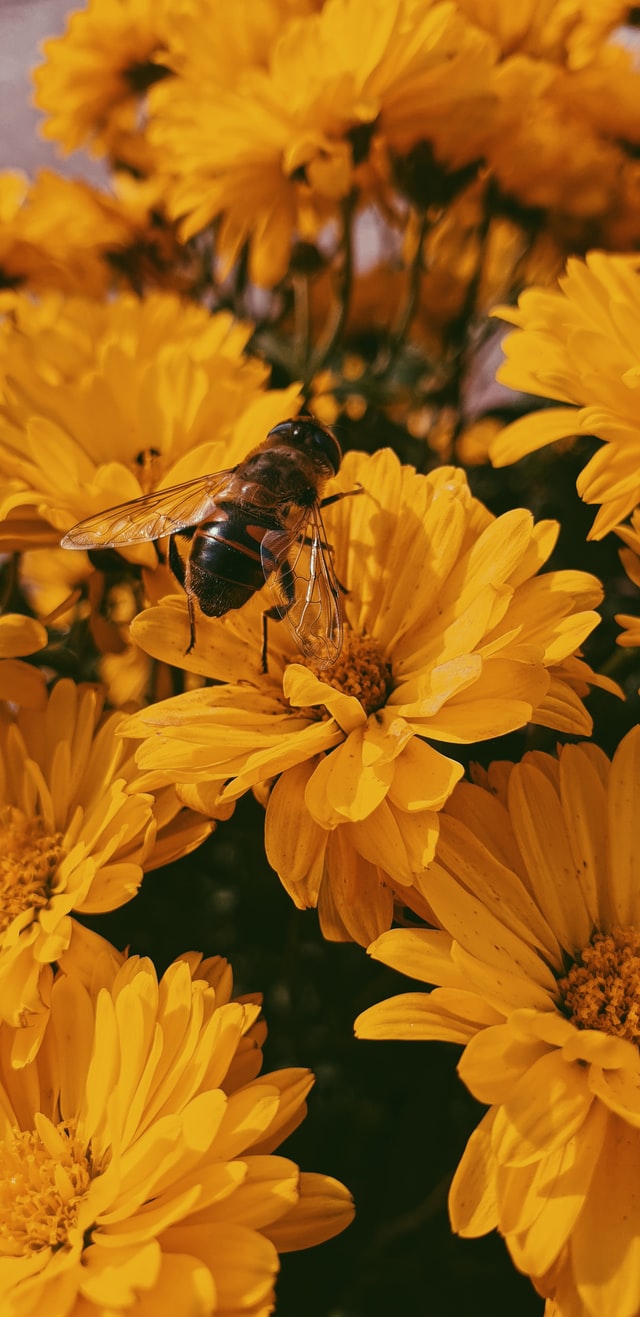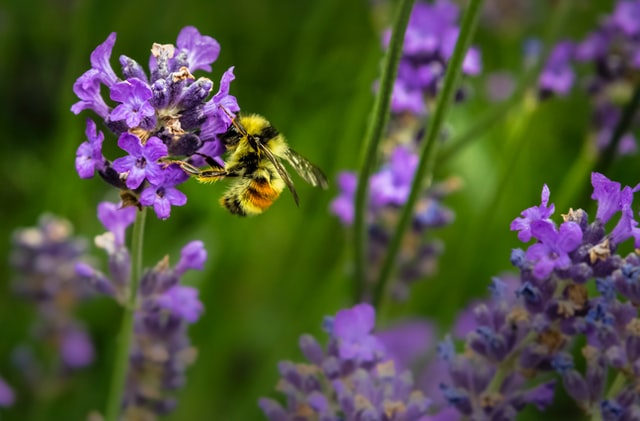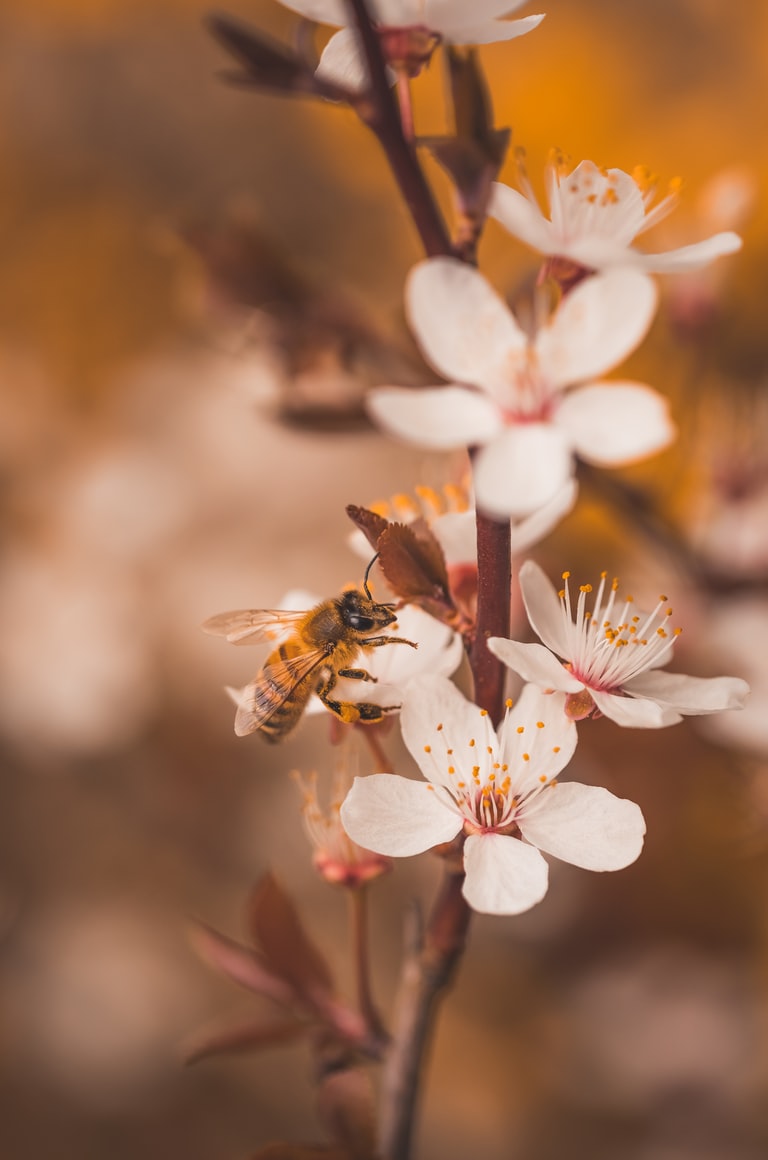As an Amazon Associate, I earn from qualifying purchases
If you’re a gardener, you know that bees are essential for pollination. Without bees, many plants wouldn’t be able to produce fruit or flowers. That’s why it’s important to plant flowers and plants that attract bees to your garden. In this article, we will discuss some of the best plants for attracting bees, as well as some tips for keeping them healthy and happy!
Why would you want bees in your garden?
Bees are attracted to a variety of flowers and plants, including lavender, sunflowers, daisies, and clover. You can plant these flowers in your garden to help attract bees, or you can place them in pots on your patio or deck. If you have a vegetable garden, be sure to include some flowering plants as well. Bees will pollinate your vegetables, which will help them grow bigger and produce more fruit.

How to help the bees in your garden
In addition to planting flowers and plants that attract bees, you can also provide them with food and water. Place a bee feeder near your garden so the bees can get their fill of sugar water. And make sure there’s always a fresh source of water available for them to drink.
Extra tips to help bees survive in your garden:
– Plant flowers and plants that attract bees. Some of the best include lavender, daisies, sunflowers, clover, borage herbs like basil or mints such as peppermint or spearmint (these will also help keep pests away). You can plant these in pots on your patio or deck if you don’t want them growing where they’ll attract more insects than flowers).
– Provide food and water for the bees, including sugar water in a bee feeder.

Photo by Jenna Lee on Unsplash
The best flowers that attract bees
Here are some of the best flowers and plants that attract bees:
Lavender
Lavender is a beautiful flower that attracts bees, butterflies, and hummingbirds. It’s also a drought-tolerant plant, so it’s perfect for gardens in dry climates.
Sunflowers
Sunflowers are a favorite food source for honeybees. They come in a variety of colors, so you can find one to match your garden’s color scheme.
Daisies
Daisies are another favorite food source for honeybees. They’re also easy to grow, and they come in a variety of colors and sizes.
Clover
Clover is an important plant for bees because it blooms throughout the spring and summer months. It’s also easy to grow, and it’s a great addition to any garden.
Floss flower
The floss flower is a beautiful flower that attracts bees, butterflies, and hummingbirds. It’s also a very drought tolerant plant, so it’s perfect your garden in dry climates.
Borage
Borage is a beautiful flower that attracts bees, butterflies, and hummingbirds. It’s also a very drought tolerant plant, so it’s perfect your garden in dry climates.
Salvia
Salvia is a beautiful plant that can attract pollinators like bees. Why? Because it’s a plant that provides both nectar and pollen.
Penstemon
Penstemon is a perennial plant that attracts bees and hummingbirds.
Aster
Asters are a perennial plant that attracts bees and hummingbirds. They’re also easy to grow, which makes them perfect for beginners!
Sedum
Sedum is an annual plant that’s great for attracting bees. Why? Because it blooms throughout the spring and summer months, so you’ll have lots of flowers to enjoy!
Zinnia
Zinnias are a favorite plant of bees and butterflies. They come in a variety of colors, so you can find one that matches your garden’s color scheme.
Verbena
Verbena is a beautiful plant that attracts bees, butterflies, and hummingbirds. It’s perfect for gardens with a lot of sun.
Lantana
Lantana is a perennial plant that attracts bees, butterflies, and hummingbirds. It’s perfect for gardens with a lot of sun.
Marigold
Marigolds are an annual plant that attracts bees and butterflies. They come in a variety of colors! Marigolds will also help to repel bugs from your garden, so that’s a great win-win!
Pincushion flower
The pincushion flower is a beautiful flower that attracts bees, butterflies, and hummingbirds. It’s also a very drought tolerant plant, so it’s perfect for your garden in dry climates.
Petunia
Petunias are popular flowers that attract bees, butterflies, and hummingbirds. They come in so many colors, shapes so pick and choose the one you love!
Milkweed
Milkweed is an important plant for bees because it blooms throughout the summer months. It’s also a great addition to any garden!
Hollyhock
A Hollyhock is an ornamental plant in the Malvaceae family. Bees like Hollyhocks because they have a long blooming season and their pollen is high in protein.
Cosmos
What is cosmos? Cosmos are a genus of flowering plants in the aster family Asteraceae. They’re also known for their long-lasting blooms and beautiful colors! They are very colorful and are super easy to plant in your garden.
Honeywort
Honeywort is an annual plant that attracts bees. It’s easy to grow from seed or cuttings so you can get started.
Basket flower
The basket flower is a beautiful plant that attracts bees and butterflies. It’s also easy to grow from seed or cuttings so you can get started right away!
Sunflower
Sunflowers are another favorite food source for honeybees. They’re also easy to grow, and they come in a variety of colors and sizes.

Photo by Boris Smokrovic on Unsplash
Coneflower
Coneflower, Sunflowers, Asters, and Goldenrod are some of the best flowers to plant if you want to attract bees to your garden. These plants provide a steady source of nectar for bees, and they also make for beautiful additions to any landscape. If you’re looking for other plants that will bring bees flocking to your yard, you might also consider planting these flowers:
Bee Balm
These colorful flowers come in a variety of colors and are easy to grow. If you’re looking for something that grows well in the shade or partial sun, this is an excellent choice. It’s incredibly hardy and can even survive winters without protection.
Black-eyed Susan
This cheerful flower is a favorite among bees, and it’s also deer resistant. It grows well in most types of soil, making it an ideal choice for any garden.
Bluebell
These delicate flowers are a beautiful addition to any garden, and they’re also loved by bees. They grow best in moist, shady areas, so they’re perfect for gardeners who don’t have a lot of sunlight.
Butterfly Bush
This flower is named for its ability to attract butterflies, and it also attracts bees. It grows well in most types of soil and can reach heights of up to 12 feet.
Coreopsis
This daisy-like flower is another favorite among bees, and it comes in a variety of different colors. It thrives in most types of soil, so it’s a great choice for gardeners who aren’t sure what to plant.
Echinacea
This colorful flower is a favorite among bees, and it also has medicinal properties. It grows best in sunny areas, so make sure to plant it in an area that gets plenty of sunlight.

Photo by Nicole Pearce on Unsplash
Foxglove
This beautiful flower is loved by bees and hummingbirds, and it grows well in most types of soil. It’s also a great choice for gardeners who want to attract butterflies to their gardens.
Money plant
This plant grows well in most types of soil, and it’s also a favorite among bees. It’s easy to grow and thrives in areas that get plenty of sunlight. It can reach heights of up to five feet tall if you make sure to prune it regularly.
Mountain Mint
These beautiful flowers are loved by bees and hummingbirds, and they grow best in moist soil. They’re also a great choice for gardeners who want to attract butterflies to their gardens but don’t have a lot of room.
Red clover
Red clover, blackberry, lavender, thyme, and oregano are some of the plants that attract bees. These plants provide pollen and nectar for bees to eat, which helps them produce honey. Bee-friendly flowers also come in a variety of colors, so you can choose the ones that best match your garden’s color scheme.
Blueberry
Blueberry is another plant that attracts bees. This fruit-bearing shrub provides a source of nectar for bees, and the blueberries themselves are a tasty treat for both humans and animals.
Lupine
Lupine is a beautiful wildflower that grows in many parts of the United States. This plant is a favorite of bees, because it produces large amounts of nectar. Lupine can be grown in your garden or used as a wildflower meadow.
Cape Daisy
The cape daisy is a brightly colored flower that grows in South Africa. This plant is beloved by bees, who feast on its nectar-rich blooms. Cape daisy flowers come in shades of yellow, orange, and red, making them a perfect addition to any garden.
Baby Blue eyes
Baby blue eyes is a delicate wildflower that can be found in many parts of the United States. This flower gets its name from its small, blue petals. Baby blue eyes is a favorite of bees, who love to feast on its nectar-rich blooms.
Alyssum
Alyssum is an annual flower that grows in many parts of the United States. This plant blooms from spring to fall, making it a great choice for gardeners who want to attract bees throughout most of the year. Alyssum flowers come in shades of purple.
Stock
Stock is a perennial flower that grows in many parts of the world. This plant produces large, showy flowers that are beloved by bees. Stock flowers come in shades of pink, white and red.
Angel’s trumpet
Angel’s trumpet is a tropical plant that can be found in many parts of the world. This plant produces large, fragrant flowers that are beloved by bees. Angel’s trumpet flowers come in shades of white, yellow, and pink.
Anise
Anise is a herb that grows in many parts of the world. This plant produces small, star-shaped flowers that are beloved by bees. Anise flowers come in shades of white and pink.
Hyssop
Hyssop is a herb that grows in many parts of the world. This plant produces small, blue flowers that bees love. Hyssop flowers come in shades of blue and purple.
Lemon Balm
Lemon balm is an herb that grows in many different parts of the world. Lemon balm flowers come in shades of pink and white.
Rosemary
Rosemary is a type of herb that grows in many parts of the world. This plant has blue flowers that bees love. The flowers can come in shades of pink and red.
Sage
Sage is a type of herb that grows in many parts of the world. This plant has small, purple flowers that bees love.
Valerian
Valerian is an herb that grows in many parts of the world. Did you know cats love Valerian as well? Bees love Valerian because of the nectar it produces.
Chives
I love chives in salads, but bees love it, too. Chives are a member of the onion family and produce small, purple flowers.
Mint
Mint is an herb that grows in many parts of the world. This plant produces small, white flowers that bees love. Mint can be grown indoors or outdoors; it prefers cool temperatures to thrive. The leaves have a strong scent when crushed, so be careful not to let it overtake your garden (that’s why I only plant mint in containers).
Oregano
Oregano is a type of herb that grows in many parts of the world. This plant produces small, pink flowers that bees love. Oregano can be grown indoors or outdoors; it prefers warm temperatures to thrive. The leaves have a strong scent, and you have to be careful not to let it overpower your garden (a bit like mint).
Basil
Basil is an herb that grows in many parts of the world. This plant produces small, purple flowers that bees love. Basil can be grown indoors or outdoors; it prefers warm temperatures to thrive.
Catnip
Catnip is a type of herb that grows in many parts of the world. This plant produces small, white flowers that bees love. Catnip can be grown both indoors or outdoors and it prefers cool temperatures to thrive. The leaves have a very strong scent when crushed, and cats adore it! (This might actually lure cats onto your garden).
Summary
This article provides a guide to flowers and plants that attract bees. It includes information on a variety of different plants, including their bloom times and the colors of their flowers. The article also includes information on why bees are drawn to these particular plants. Finally, it provides a list of some herbs that also produce flowers that are attractive to bees.
Bees are an important part of our ecosystem, and they play a vital role in pollination. By planting flowers and plants that attract bees, you can help these valuable creatures thrive! Thanks for reading!

If you’re looking for more information about attracting bees to your garden, be sure to check out these websites: